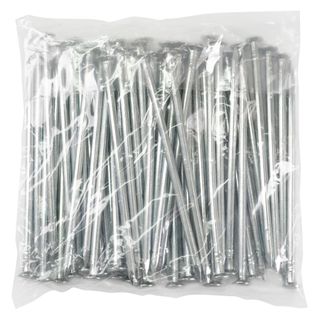
Galvanised Pins for Artificial Grass
A vital step in securing your artificial grass to softer surfaces like rock sub-base, is pinning it down with Aloro's artificial grass fixing pins. Skipping this step can lead to poorly laid artificial grass, but by pinning artificial grass you can rest assured that your turf stays in place. This prevents gradual movement, uneven surfaces or unsightly wrinkles.
Artificial grass pins, also known as synthetic grass pins or artificial grass nails, are a vital component in securing your turf to materials such as hard soils and clay sub-bases. Fake grass pins enable you to professionally transform any area or space when you're installing artificial grass for landscaping.
In addition to our artificial grass pins, Aloro Group also stocks other essentials for a successful installation, including galvanised pins, joining tape, artificial grass adhesive, and special dried sand for artificial grass. These products are designed and chosen to complement our range of synthetic turf products, providing a comprehensive solution for your landscaping needs.
With over 20 years of experience as a leading Australian provider of synthetic turf systems, Aloro Group prides itself on supplying only the highest quality products and services. Our reputation is built on our commitment to our customers, providing you with top-tier artificial grass solutions that are practical, long-lasting, cost-effective and aesthetically pleasing.
If you have any questions regarding our artificial grass pins or the installation process, contact Aloro Group – our team is always here to help you get the best results.
-
TPSCREW-ALORO-150-50Unit Of Measure:pk
Artificial Grass Pins Frequently Asked Questions
Do You Always Need To Pin Down Artificial Grass?
Yes, if you have a rock or gravel base, we highly recommend you pin down your artificial grass to maintain the integrity and appearance of the turf. Pinning down artificial grass is a key step in the installation process, ensuring that your artificial grass stays in place, drains properly, and looks its best for years to come. For applications with solid surfaces, such as a concrete slab, we recommend using artificial grass adhesive instead.
Synthetic turf differs from natural grass in several ways, including: minimal maintenance requirements, resistance to weather and environmental conditions, consistent appearance and green colour, and being suitable for high-traffic areas.
How Do You Use Artificial Grass Fixing Pins?
Fixing pins for artificial grass are used to secure the perimeter of your turf by driving them into the ground approximately every 300mm. Aloro Group stocks screw-type pins that securely fasten the turf layer and sit flush with the ground. Artificial grass pins should be placed along the perimeter of the turf plus at regular intervals across the surface of the turf. Pay close attention to joined sections, adding extra pins if needed. By stretching and securing the edges of your artificial grass, you’ll create a neat and professional finish, fastening the edges of the synthetic grass firmly to the perimeter of your yard, sports field, or landscaped area.
How Many Pins Do I Need For My Artificial Grass Installation?
Our galvanised pins are available in packs of 50, but the number of galvanised pins for artificial grass required depends on the size of the area being covered. Artificial grass pins should be placed every 300mm along the perimeter and also at regular intervals throughout the entire area. So, to determine the quantity you need, multiply the perimeter distance in metres by 0.3 to give you an approximate number of pins. Round this up to the next multiple of 50, and this is the number of packs you’ll need.
What Happens If I Damage A Pin Or It Comes Loose?
If a pin is damaged or comes loose, it's important to replace it as soon as possible to prevent any potential damage or tears in your artificial grass. Loose or damaged pins can compromise the integrity of your installation, leading to issues such as shifting or wrinkling of the turf. They can also be sharp and pose a safety hazard.
Do I Need To Replace The Pins?
Over time, synthetic grass pins may become loose or corroded. It's important to regularly inspect the pins and replace any that are damaged or those that no longer secure the turf effectively. Regular maintenance of your artificial grass pins will ensure that your turf remains secure and beautiful for many years to come.

